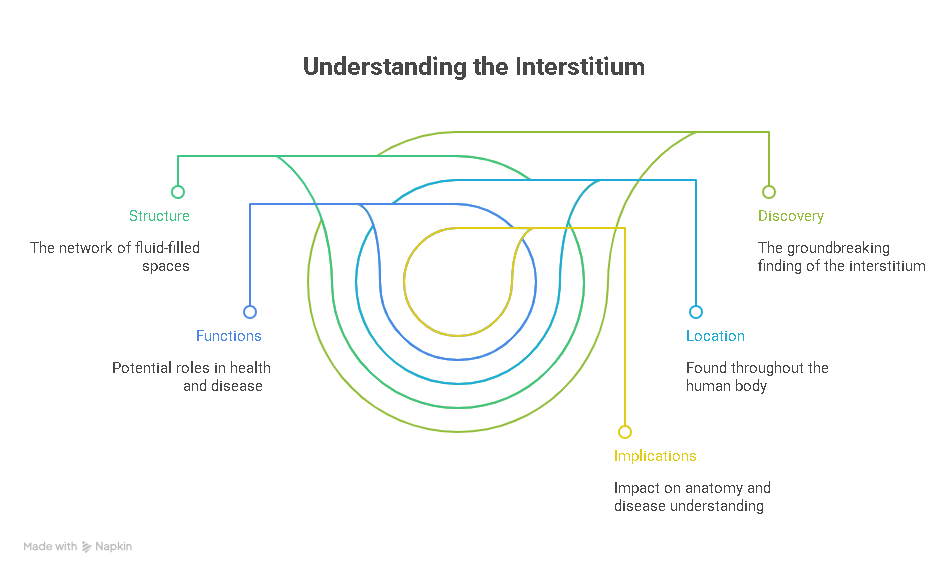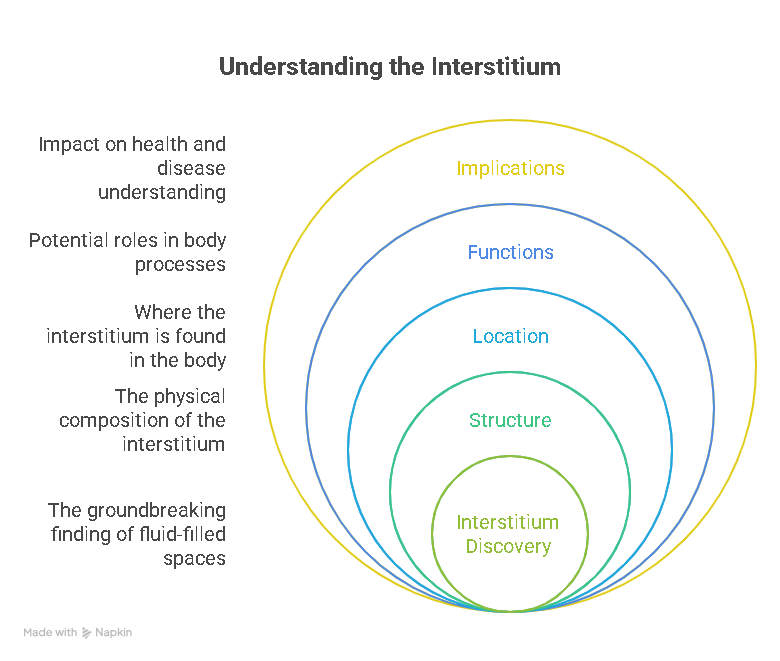Discover the fascinating world of the interstitium – a newly recognized, fluid-filled network within our tissues. Learn why this breakthrough matters for your health and future medical science.
What Is the Interstitium?
Imagine a hidden highway system inside your body – one that helps transport fluids, supports tissue structure, and possibly plays a role in disease. This is the interstitium, a recently redefined and astonishingly important network of fluid-filled spaces within and between your tissues.
For years, medical textbooks described the human body as a tightly packed structure of cells, tissues, and organs. However, recent research has revealed a previously overlooked network of interconnected, fluid-filled spaces called the interstitium. This network exists beneath the skin, lining the digestive tract, lungs, blood vessels, and muscles.
Imagine a sponge-like structure interwoven throughout your body. That’s essentially what the interstitium is. These spaces are supported by a meshwork of collagen and elastin proteins, providing both structural integrity and flexibility. The fluid within these spaces, known as interstitial fluid, is distinct from blood and lymph, although it interacts with both.
How Was It Discovered?
The interstitium remained hidden for so long due to the traditional methods used to prepare tissue samples for microscopic examination. These methods typically involve fixing tissues, which drains the fluid and causes the interstitial spaces to collapse, making them appear as dense connective tissue.
The breakthrough came with the development of a new imaging technique called confocal laser endomicroscopy. This technique allows scientists to examine living tissues in real-time, without the need for fixation. Using this method, researchers were able to observe the fluid-filled spaces of the interstitium in their natural state.
The discovery was initially made during a study of bile ducts. Researchers noticed these previously unseen spaces and realized they were widespread throughout the body. This led to the groundbreaking publication in the journal Scientific Reports in 2018, which officially announced the discovery of the interstitium as a new organ.
Where is the Interstitium Located?
The interstitium is not a single, discrete organ like the heart or liver. Instead, it’s a widespread network that permeates much of the body. Key locations include:
- Beneath the skin: This is where the interstitium is most abundant, providing cushioning and support.
- Lining the digestive tract: The interstitium here plays a role in nutrient absorption and immune function.
- Lungs: The interstitium supports the delicate air sacs (alveoli) and facilitates gas exchange.
- Blood vessels: The interstitium surrounds blood vessels, influencing fluid balance and blood pressure.
- Muscles: The interstitium provides lubrication and support for muscle fibers.
- Urinary system: The interstitium is present in the kidneys and bladder.
Essentially, wherever there is connective tissue, there is likely to be interstitium.

What are the Potential Functions of the Interstitium?
While research is still ongoing, scientists believe the interstitium plays several important roles in the body:
- Fluid Balance: The interstitium acts as a reservoir for fluid, helping to maintain fluid balance throughout the body. It collects fluid that leaks from blood vessels and returns it to the lymphatic system.
- Shock Absorption: The fluid-filled spaces of the interstitium provide cushioning and protection for organs and tissues, acting as a shock absorber.
- Immune Function: The interstitium contains immune cells that help to defend against infection. It also serves as a pathway for immune cells to travel throughout the body.
- Nutrient and Waste Transport: The interstitial fluid facilitates the transport of nutrients and waste products between cells and the bloodstream.
- Mechanical Signaling: The interstitium may play a role in transmitting mechanical signals between cells, influencing cell behavior and tissue function.
Implications for Health and Disease
The discovery of the interstitium has significant implications for our understanding of health and disease. Here are a few potential areas of impact:
- Cancer: The interstitium may play a role in the spread of cancer. Cancer cells can use the interstitial spaces to travel to other parts of the body, leading to metastasis. Understanding how cancer cells interact with the interstitium could lead to new strategies for preventing and treating cancer.
- Edema: Edema, or swelling, is caused by an accumulation of fluid in the tissues. The interstitium plays a key role in fluid balance, so understanding its function is crucial for understanding and treating edema.
- Fibrosis: Fibrosis is the formation of excessive connective tissue, which can lead to organ damage. The interstitium is composed of connective tissue, so understanding its role in fibrosis could lead to new treatments for fibrotic diseases.
- Inflammation: The interstitium is involved in the inflammatory response. Understanding how inflammation affects the interstitium could lead to new treatments for inflammatory diseases.
- Drug Delivery: The interstitium could be a target for drug delivery. By understanding how drugs are transported through the interstitium, scientists could develop more effective drug delivery systems.
The Future of Interstitium Research
The discovery of the interstitium is a relatively recent development, and much remains to be learned about its structure, function, and role in health and disease. Future research will likely focus on:
- Detailed characterization of the interstitial fluid: Understanding the composition and properties of the interstitial fluid is crucial for understanding its function.
- Investigating the role of the interstitium in specific diseases: Further research is needed to understand how the interstitium contributes to the development and progression of various diseases.
- Developing new imaging techniques: New imaging techniques are needed to visualize the interstitium in more detail and to study its function in real-time.
- Exploring therapeutic applications: The interstitium could be a target for new therapies for a wide range of diseases.
The discovery of the interstitium has revolutionized our understanding of human anatomy and physiology. This widespread network of fluid-filled spaces plays a crucial role in fluid balance, shock absorption, immune function, and nutrient transport. Further research into the interstitium promises to unlock new insights into health and disease, leading to new diagnostic and therapeutic strategies. The interstitium, once overlooked, is now recognized as a vital component of the human body, offering exciting new avenues for scientific exploration and medical advancement.

Long considered just dense connective tissue, the interstitium was reclassified as a dynamic organ-like structure only recently. Researchers now believe it may be among the largest organs in the human body. This discovery has shaken up traditional anatomy and could open powerful new doors in medical science.
Where Is the Interstitium Located?
The interstitium is everywhere – beneath your skin, lining your digestive tract, lungs, and urinary system. It surrounds muscles, blood vessels, and every organ. Rather than being a solid wall of collagen, it’s made up of collagen and elastin fibers suspended in fluid-filled channels, which act like tiny shock absorbers and transport highways.
Why the Interstitium Matters for Your Health
Understanding the interstitium is more than just a scientific curiosity. It could revolutionize how we approach inflammation, cancer spread, aging, and even chronic pain.
Here’s how:
- A New Pathway for Cancer Spread
Cancer doesn’t just spread through the blood or lymph. The interstitium may provide a low-resistance path for cancer cells to travel, offering new insight into how metastasis works. - A Hidden Role in Inflammation and Swelling
Because it helps regulate interstitial fluid (the fluid between cells), the interstitium might play a major role in inflammatory diseases like lupus, arthritis, and edema. - Impact on Aging and Skin Health
The collagen and elastin within the interstitium contribute to skin elasticity. As we age, changes in this structure may drive visible skin aging and tissue stiffness. - Game-Changer in Diagnostics
With new imaging techniques like probe-based confocal laser endomicroscopy (pCLE), scientists are now able to see these fluid-filled structures in living tissue — something previously impossible with traditional slides.
How Was the Interstitium Discovered?
The breakthrough came when scientists noticed strange fluid-filled patterns while using advanced imaging techniques during endoscopic procedures. Unlike the flat tissue samples typically studied under microscopes, these live images revealed an active, dynamic network of interconnected spaces — the interstitium.

Could the Interstitium Be a New Organ?
This is the million-dollar question. Some experts propose it may be classified as a new organ, given its widespread presence and important functions. Others urge caution, suggesting it’s part of the connective tissue system rather than a standalone organ.
Regardless of classification, the biological significance of the interstitium is undeniable — and exciting.
The Future of Interstitium Research
We’re just scratching the surface. Ongoing research may reveal how this fluid-filled framework influences:
Immunity
Fibrosis and scarring
Drug delivery mechanisms
Stem cell behavior
As understanding deepens, we could see new therapies for cancer, autoimmune diseases, and even strategies to slow aging.
Final Thoughts
The discovery of the interstitium is a thrilling reminder that even in the 21st century, the human body still holds surprises. This hidden highway may shape the future of medicine in ways we’re only beginning to imagine.
So the next time you think you know your anatomy — remember, your body has fluid-filled secrets, and the interstitium is one of its most astonishing.
interstitium, fluid-filled spaces, human anatomy, cancer spread, interstitial fluid, connective tissue, organ system, inflammation, aging, health science
Frequently Asked Questions (FAQ) About the Interstitium
- Is the interstitium really a new organ?
While it hasn’t been officially classified as a separate organ, some scientists suggest the interstitium qualifies due to its structure, function, and size. It’s still under debate, but its significance in health and disease is undisputed. - What does the interstitium do in the body?
The interstitium provides structural support, shock absorption, and serves as a fluid transport system. It may also be involved in immune response, tissue repair, and disease progression. - Can damage to the interstitium cause disease?
Yes. Conditions like inflammation, fibrosis, and fluid retention (edema) may involve interstitial dysfunction. Early research also suggests it could play a role in autoimmune and cancerous conditions. - Is the interstitial fluid the same as lymph?
Not exactly. Interstitial fluid bathes and nourishes cells, while lymph is the fluid that drains from interstitial spaces into the lymphatic system. They are related but functionally different. - How can we support healthy interstitial function?
While more research is needed, hydration, anti-inflammatory nutrition, and regular movement support healthy tissue fluids. Avoiding chronic stress and managing inflammation may also help maintain interstitial health.
How This Discovery Could Revolutionize Medicine
The interstitium may be the missing link in explaining how fluids move, how inflammation spreads, and why certain therapies fail or succeed. Its study may usher in:
More accurate cancer diagnostics
Earlier detection of organ fibrosis
New methods for delivering drugs directly to tissues
In the near future, targeted interstitial therapies could help manage chronic illnesses, enhance healing, and even reverse certain age-related changes.
The interstitium may be one of the largest organs in your body — and we just recently discovered it!
🧭 The Future of Research
🔹 Early disease detection
🔹 Interstitial-targeted therapies
🔹 Better cancer diagnostics
🔹 Insights into autoimmune diseases
